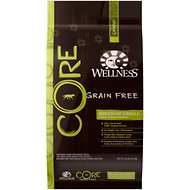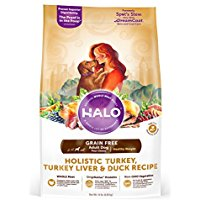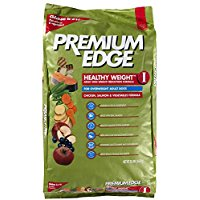Best Low Fat Dog Foods for Pancreatitis
Quick Guide
When it comes to your own diet, you have probably had the idea drilled into your head that fats are bad. While it is true that trans fats, hydrogenated oils, and some saturated fats are not good for you, there are certain kinds of fats that are. The same is true for your dog!
Fat is actually the most concentrated source of energy for your dog and it plays a key role in his diet. For some dogs with certain health problems, however, high fat content can be dangerous. Keep reading to learn the importance of fat in dog food as well as key information about conditions that might necessitate a low fat diet. Furthermore, you will find recommendations for choosing a low fat dog food and reviews of some of the top recommended brands of low fat dog food.
Do you know the Top Recommended 4-Star Dog Food Brands 2025
| The Scoop : Best Low Fat Dog Food of 2025 | |||
| Rank | Product | Price | Rating |
| #1 |
 | $2.61/lb |
A+
|
| #2 |
 | $2.12/lb |
A
|
| #3 |
 Halo Spot’s Stew Grain-Free Healthy Weight Turkey Liver and Duck Dry | $2.49/lb |
A
|
| #4 |
 | $1.47/lb |
A
|
The Importance of Fat in a Dog’s Diet
Like all living things, dogs require a balance of the three macronutrients in their diet – protein, fat, and carbohydrate. Protein is the most essential nutrient for dogs because it contains the amino acids that are needed to build healthy muscles and tissue – it also provides healthy energy for your dog. What many dog owners do not realize, however, is that fat is actually a more concentrated form of energy than protein. Protein and carbohydrates contain 4 calories per gram while fat contains 9 calories per gram. Calories are a unit of energy, so this is a big deal. When measured by weight, fats contain 2.25 times more energy than an equal weight of protein or carbohydrates.
When it comes to choosing specific fats for your dog, it is always best to stick with animal-based fats like chicken fat or salmon oil. Animal-based fats are more biologically valuable for your dog which means that he will have an easier time digesting them and absorbing the nutrients they provide. Many pet foods use plant-based fats like flaxseed oil or coconut oil. While many plant-based fats offer good nutritional value and are not inherently harmful for dogs, they will still be less biologically valuable than an animal fat. For this reason, it is best to find a dog food product that uses an animal-based source as the primary source of fat – it is okay if it is supplemented with a plant-based fat as a secondary source.
In terms of the types of fat your dog needs, essential fatty acids are the most important. The three most important fatty acids for dogs are linoleic acid, alpha-linolenic acid, and arachidonic acid. These essential fatty acids should comprise about 2% of your dog’s daily calorie intake. As for your dog’s total fat requirement, adult dogs need a diet that is comprised of at least 5% fat with the ideal recommendation being between 9 and 15%. Puppies need a minimum of 8% with an ideal recommendation of 17% – the same recommendations hold true for pregnant and lactating females. Very active dogs need higher than average fat levels, a minimum of 8% with ideal levels being closer to 35%.
Also Read: 8 Best Foods to Feed an Adult and Puppy Maltipoo in 2025
When is a Low Fat Diet Necessary for Dogs?
As important as fat is as part of a balanced diet for dogs, some dogs need to be fed a moderate- or low-fat diet because they have certain health conditions. For example, dogs with sensitive stomachs can sometimes have trouble with high fat diets. Fat is more difficult for dogs to digest than protein, so if you feed your dog a product with high levels of fat, it could result in digestive upset. Another reason a dog might need a low fat dog food is if he is overweight or obese. Many dog owners do not realize that table scraps and other kinds of people food are very high in calories for dogs and feeding your dog too many treats can lead to unhealthy weight gain or obesity. Once your dog is overweight or obese, his risk for other serious health problems increases as well.
Though digestive problems and obesity are good reasons to switch your dog to a low fat diet, the most common reason is a medical condition called pancreatitis. This is a condition in which the dog’s pancreas, an organ that works closely with the stomach to help digest food, becomes inflamed. The more inflamed the dog’s pancreas becomes, the more it impedes his ability to digest food and to absorb nutrients from the food he eats. Some of the most common symptoms of pancreatitis include vomiting and loss of appetite, but other symptoms may include lethargy, diarrhea, fever, difficulty breathing, rapid heartbeat, and dehydration. In many cases, pancreatitis remains a mild disease but it can become severe and, in rare cases, be fatal.
Unfortunately, the exact cause for pancreatitis in dogs remains unknown, though there are several theories. Pancreatitis is often linked with a sudden intake of very high fat foods (like the skin from your Thanksgiving turkey) but there also seems to be a genetic component. Another potential cause is hyperlipidemia, or high fat levels in the blood or hypercalcemia, high calcium levels in the blood. Some experts suggest that pancreatitis is caused by certain bacterial infections or that it might be a side effect of certain diseases like Cushing’s disease. Additionally, it seems as though some breeds have a higher risk for developing pancreatitis (like Schnauzers, Yorkshire Terriers, Poodles, and Cocker Spaniels), and it is more common in old and overweight dogs.
What Constitutes a Low Fat Dog Food?
According to the Whole Dog Journal, a diet that contains less than 10% fat on a dry matter basis is considered to be low fat – diets containing 10% to 15% fat are moderate fat. Fat contents above 35% when measured on a dry matter basis indicate a high fat diet. If you aren’t familiar with how pet food labeling works, you may not know what “dry matter basis” means. All pet foods contain some amount of moisture – dry foods usually have about 10% moisture while canned foods usually have a minimum of 78%. If you want to make a direct comparison between dry dog food and wet dog food, you need to convert the crude fat percentage of the wet food to dry matter. To do so, subtract the crude moisture content from 100 then divide the result by the crude fat percentage.
Even if you convert the crude fat content to a dry matter basis, the percentages provided by the guaranteed analysis on a pet food label only give you a rough estimate – the values usually say “Minimum” or “Maximum” next to them. If you want to determine the exact fat content of a pet food product you will need to calculate the grams of fat per 1,000 calories. This measurement is a much more accurate estimation of the fat content of a pet food product which means it is a more valuable tool for you to use if you are looking for a low fat dog food. To determine the grams of fat per 1,000 calories, refer to the nutritional information on the package and the feeding instructions to determine your dog’s total daily intake. Then, divide the crude fat percentage by the total number of calories.
According to veterinary nutritionists, a low fat dog food contains fewer than 25 grams of fat per 1,000 calories. To give you a frame of reference as to what this looks like, here is a list of different fat percentages and calorie content that translate to 25 grams of fat per 1,000 calories:
- 2.5% crude fat and 1,000 calories/kg
- 5% crude fat and 2,000 calories/kg
- 7.5% crude fat and 3,000 calories/kg
- 10% crude fat and 4,000 calories/kg
As you start shopping around for low fat dog food, keep an eye out for recipes that are excessively low in fat. Some low fat dog foods offer as little as 5 to 8 grams of fat per 1,000 calories which is much too low for any dog. If you convert the minimum fat requirements for dogs offered earlier, the minimum requirement for adult dogs is around 11 grams of fat per 1,000 calories. If you give your dog a diet that is too low in fat, it could exacerbate his current health problems and contribute to new ones. Extremely low-fat diets can lead to deficiencies in various fat-soluble vitamins and it can destroy the condition of your dog’s skin and coat. Many dogs experience very low energy levels on extremely low fat diets and they will feel hungry all the time because they don’t have enough slow-burning energy in their diets.
Tips for Choosing a Quality Low Fat Food
Unfortunately, there is a lot of conflicting information out there regarding low fat diets for dogs. Many pet food manufacturers offer weight loss or healthy weight formulas that contain fewer calories than their traditional products but when it comes to reducing the calorie count, they go about it all wrong. It is not uncommon for pet food manufacturers to reduce the fat content of their products by reducing the meat content. Protein is absolutely essential for all dogs and reducing the meat content of a dog food formula will reduce the protein content as well. For this reason, you should look for a high-quality animal-based protein as the main ingredient in any low fat dog food.
Once you’ve determined that there is enough animal-based protein in the product, you can take a look at the rest of the ingredients. Check for a wholesome source of digestible carbohydrates like brown rice or oats. If your dog has a sensitive stomach or is prone to food allergies, you may want to steer clear of grains and choose a product made with sweet potatoes, green peas, or other legumes. Next, look for quality sources for omega fatty acids such as fish oil and flaxseed. Even if you are shopping for a low fat dog food you want to make sure that your dog’s minimum fat requirements are met – use the information from the last section to determine the grams of fat per 1,000 calories, making sure not to choose a product that goes below 11 grams of fat per 1,000 calories.
In addition to making sure that the low fat dog food you choose is made with meat as the first ingredient plus wholesome carbohydrates and moderate fat content, you want to take a look at the specific ingredients that are used. Remember, animal-based ingredients are always more biologically valuable than plant-based ingredients. When it comes to nutritional balance, however, you do want to see some plants on the list – primarily fresh fruits and vegetables that can provide natural sources for key nutrients. In terms of supplements, chelated minerals are the most valuable because they have been chemically bound to protein molecules which makes them easier for your dog’s body to digest and absorb. Dried fermentation products (a type of probiotic) are also valuable additions to low fat dog food because they will help improve and regulate your dog’s digestion.
Should You Consider a Homemade Low Fat Diet?
Many pet owners who are concerned about the health and nutrition for their pets make the switch to homemade dog food. Making your own dog food enables you to have complete control over what is and is not included in your dog’s diet and you have the freedom to customize the recipe according to your dog’s individual preferences. What many dog owners do not realize, however, is that it is very difficult to make a homemade dog food that is complete and balanced. You should never feed your dog homemade dog food unless the recipe is properly formulated, ideally by a veterinarian or animal nutritionist.
When it comes to homemade low fat dog food there are a few general rules to follow:
- The diet should consist of about 50% carbohydrates and 50% low-fat meats, eggs, and dairy.
- Most of the carbohydrate content should come from starchy foods and whole grains.
- Meats should be cooked to remove some of their fat and skins should be removed.
- Eggs are rich in nutrients and should be included in amounts proportionate to your dog’s size.
- Dairy products should be low-fat or nonfat – avoid hard cheeses (even low-fat ones).
- Don’t forget to include organ meat in your homemade diet (about 5% to 10% of the total).
Ensuring complete and balanced nutrition with a homemade low fat dog food is very challenging, but it can be done with the right supplements. Make sure that your dog’s diet includes enough calcium. One way to accomplish this is to create a diet that is 35% raw meaty bones. Because these bones can be high in fat, however, you may be better off using a powdered nutritional supplement designed for use with homemade dog foods. You may also find that some pet food manufacturers offer base mixes – food products that are nutritionally complete and can be added to fresh meat and other ingredients to create a balanced homemade diet.
Recommendations for Top Low Fat Dog Food Brands
When you are ready to start shopping for low fat dog food, there are many factors you need to consider. First, you need to make sure that the product will meet your dog’s need for protein, then you can calculate the grams of fat per 1,000 calories to make sure it is a low fat dog food but not an extremely low fat dog food. You also want to check for quality ingredients. Fresh meats and animal-based fats are the primary ingredients that add flavor to a dog food – this is why many low fat dog foods are less palatable for some dogs. If this becomes a problem, try soaking your dog’s food in low-sodium broth or stir in a little bit of low fat wet dog food. To help you get started with your search you will find reviews of some of the top brands of low fat dog food below.
Wellness CORE Reduced Fat Dry
First 5 Ingredients : Deboned Turkey, Turkey Meal, Chicken Meal, Potatoes, Peas

The Wellness pet food company is dedicated to providing high-quality, natural diets for pets. This company follows a holistic approach to pet nutrition and they make it their goal to use “nature’s finest ingredients… combining them in exact proportions to help support your pet’s health and wellbeing”. Not only does Wellness seek to produce high-quality pet foods, but they also support various animal wellness programs and educate pet owners about the importance of a healthy diet and lifestyle for their pets. When it comes to their products, Wellness offers their customers the “Wellness difference” which promises an ideal balance of protein, fat, and carbohydrate with no “empty calories”. Each and every one of Wellness’ products is made with premium protein as the first ingredient and is balanced with a variety of fresh, wholesome ingredients for nutritional balance.
Wellness offers a wide variety of different products divided over several product lines. The CORE line of products is one of the most popular and it consists of grain-free recipes for kibble as well as air-dried dog food. If you are looking for a low fat dog food, consider the Wellness CORE Reduced Fat Dry Dog Food formula. This recipe contains 25% less fat than the original CORE adult dog recipe but it still retains its high protein content. Made with chicken, turkey, and salmon oil, this formula offers balanced nutrition and plenty of natural flavor. This recipe is completely free from meat by-products and non-nutritive fillers as well as artificial additives. It contains both fish oil and flaxseed to ensure a balance of omega-3 and omega-6 fatty acids as well, so it will leave your dog’s coat looking and feeling great. Plus, its reduced calorie content will help your dog achieve and maintain a healthy weight.
Dr. Tim’s Metabolite Weight Management Dry
First 5 Ingredients : Chicken Meal, Brown Rice, Whole Oat Groats, Dried Field Peas, Powdered Cellulose

Dr. Tim’s is an all-natural line of premium pet food products. Each and every recipe is carefully formulated to deliver complete and balanced nutrition for your dog using only the highest quality ingredients available. Each recipe is based on premium animal proteins, supplemented with wholesome carbohydrates, healthy fats, and plenty of dietary fiber. Dr. Tim’s uses a unique slow-cooking process to preserve the nutritional integrity of raw ingredients – it also renders his products easily digestible and highly palatable. Dr. Tim’s is a family-owned business and every recipe is carefully formulated with input from Ph.D. canine nutritionists and veterinarians with a slant toward practical nutrition for athletic and working breed dogs. According to the brand website, Dr. Tim’s proteins are 87% animal derived and every recipe is free from corn, wheat, and soy ingredients.
For a low fat dog food that meets your dog’s nutritional needs, consider the Dr. Tim’s Metabolite Weight Management Dry Dog Food formula. This recipe takes a unique approach to weight reduction for dogs, using high-quality proteins and specific fibers with moderate fat content to support “your pet’s natural metabolism and to support weight loss”. This formula features protein-rich chicken meal as the primary ingredient and it is supplemented with brown rice, oat groats, and yellow peas as the main carbohydrates. This formula actually helps to increase your dog’s metabolic rate to help him burn more calories while still maintaining his lean muscle mass. With a balance of essential fatty acids, this product also supports your dog’s healthy skin and coat and boosts his immune system. For a delicious and healthy low fat dog food, consider this Dr. Tim’s Metabolite Weight Management Dry Dog Food formula.
Halo Spot’s Stew Grain-Free Healthy Weight Turkey Liver and Duck Dry
First 5 Ingredients : Turkey Liver, Peas, Turkey, Ground Peas, Pea Protein

The Halo Purely for Pets company has been around for more than 25 years and it has become one of the leading innovators in the holistic pet food industry. It is this company’s goal to create “holistic pet products of uncompromising quality” – the kind of product you would be proud to feed your pet. Because Halo follows a holistic approach to pet nutrition, their recipes are made with plenty of fresh, natural ingredients to provide your dog with the nutrients he needs and nothing he doesn’t. Halo follows three guiding principles when creating their products – balance, nature, and love. When these three things are in harmony, Halo believes that everything else will fall into place. In following this philosophy, Halo has mastered the art of created all-natural pet food products that help pets achieve a happier and healthier life.
When it comes to their dry food products, Halo offers two different product lines – Vigor and Spot’s Stew. The Vigor line of products is made with carefully selected ingredients that work in harmony to boost your dog’s energy and vitality while encouraging healthy digestion. The Spot’s Stew line is an extension of Halo’s very first dog food recipe and it includes a number of classic and grain-free options. For low fat dog food, there is the Halo Spot’s Stew Grain-Free Healthy Weight Turkey Liver and Duck Dry Food formula. This recipe is complete and balanced for adult dogs and it is free from oats, corn, wheat, and barley. With turkey liver as the primary ingredient, this recipe is rich in protein with moderate fat content – it also comes with feeding recommendations to help your dog lose weight.
Premium Edge Healthy Weight Dry
First 5 Ingredients : Chicken, Chicken Meal, Peas, Egg Product, Potato Protein

The Premium Edge brand of dog food is produced and manufactured by Diamond Pet Foods that has been offering quality pet food products for more than 40 years. This company manufactures all of their products in U.S.-based facilities and they use high-quality ingredients like animal proteins and wholesome carbohydrates. This brand fortifies their pet foods with a number of helpful supplements as well, such as healthy antioxidants, chelated minerals, dried chicory root, and joint-supporting nutrients. In terms of their proteins, they use real chicken, fresh lamb, and salmon meal as their primary options. All of Premium Edge’s dog food formulas are made with the finest ingredients available and they are free from corn, wheat, and soy. You can rest assured that when you feed your dog Premium Edge dog food, you are feeding him quality.
If you are looking for a high-quality dog food that is also low in fat, consider the Premium Edge Healthy Weight Reduction Dry Dog Food formula. This recipe is one of two weight control formulas that Premium Edge has to offer – one is designed for weight reduction and the other for healthy weight maintenance. The weight reduction formula is rich in protein and low in carbohydrates, made with 44% protein and just 12% fat. It features real chicken as the primary ingredient, supplemented with salmon meal for extra protein and omega fatty acids. This recipe will help to improve the condition of your dog’s skin and coat, plus it will support his joints and boost his immune system. It also contains chelated minerals for nutritional balance and plenty of fresh flavor.
All low fat dog foods are not created equal so you need to be very careful when shopping for a commercial low fat dog food. As you start looking around, make sure to focus on products that meet your dog’s nutritional needs, especially when it comes to protein. You also need to remember that while low fat dog foods are necessary for some dogs, all dogs have a minimum fat requirement and you shouldn’t choose a product that goes below that number. Talk to your vet about whether or not your dog really needs a low fat diet and, if you decide that low fat food is the best option for your dog, consider starting with one of the recommended dog food brands reviewed above.











I have a King Charles cavalier, he’s 4 years old. He’s been diagnosed a few years ago with IBD(crohns) and just recently with pancreatitis. He’s on Budesonide for his IBD, and tylosin.
I’m getting frustrated on what to feed him. He’s currently on Royal Canin low fat gastrointestinal food, canned and dry. After having such high readings on his last blood test with his pancreas and him in such pain I took him off kibble and just fed canned, with some cooked chicken and rice. He’s better for now. What do you suggest I feed him? I’m willing to continue to cook for him but I’m dealing with both issues. Any help would be appreciated.
i did not see reply here, so just offer some help- there is a facebook group may offer some advice. I found Canidae senior adult has max fat listed 10.5% , alot of other canidae products rate high as well. alot of ppl use honest kitchen or Solid gold too .. dogfood insider also has food reviews. I am trying to do the % fat per gram calc, cant get it to come out right per this article.. but protein of my food is high, so not too low calorie. mines only 3yrs old, not overweight or senior, just needs lowfat.. heres fb link : https://www.facebook.com/groups/1435920120029740/?ref=group_header
Thank you very much for sharing your knowledge. I just applied to the Fb group. My remaining Cavaliers are two very senior girls, one with pancreatitis. The E/R vet put her on Science Diet I/D – Ugh. Thanks again!